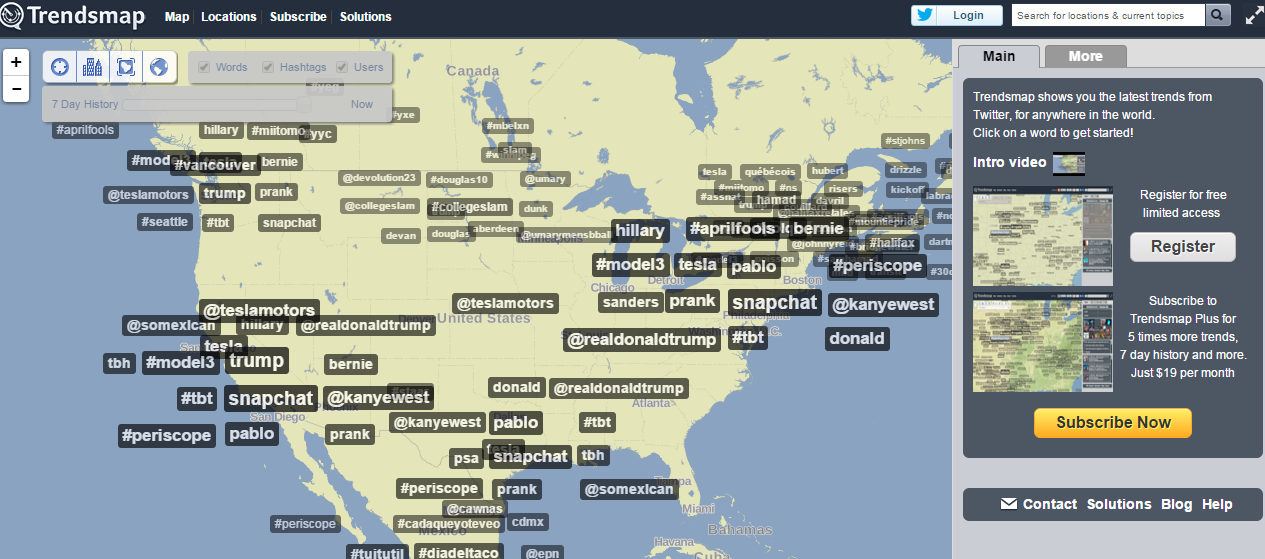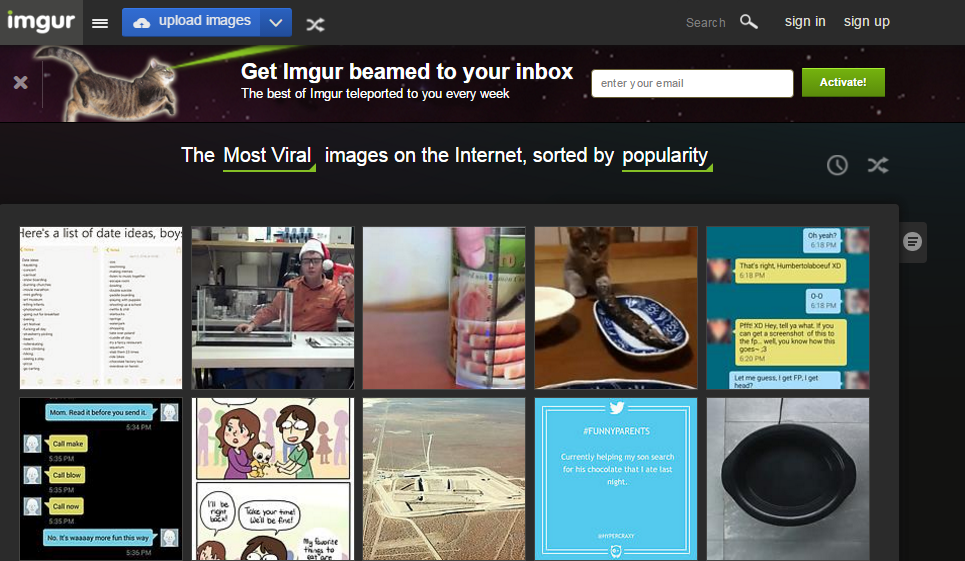There is an increasing need for online content, and both content writers and content marketers know the struggle of constantly seeking the next great post.
It’s not always easy to come up with a content idea that will lead to an interesting post, especially when there’s time pressure or, simply, lack of inspiration.
In order to maintain your productivity and feel inspired for your next post, it is helpful to get organised in advance and create a list of resources and tools that will help you find an idea for your next post.
I’ve compiled just such a list to help you next time you run out of inspiration…
Social media and trending topics
Social media may turn into your primary source of inspiration for your next post’s topic, especially when you know how to organise what you come across from time to time.
Facebook’s saved posts
Facebook introduced the ability to save posts, links, pages, videos back in 2014 and this has significantly changed the way we consume content, both personally and professionally.
By the time you come across an interesting article, all you have to do is save it for future reference.
What makes it special? The fact that we’re all using the most popular social network daily, which means that there are more chances to come across an interesting post (provided that you are already following the right sources that will inspire you accordingly).

Twitter lists
This is probably one of my favourite ways to consume content and it may be very helpful when you’re trying to follow the latest trends in the industries you’re interested in. It serves both as a source of inspiration, but also as an easy way to analyse what your competitors, or other influencers, are writing about.
It might take a while until you create the right lists, but you won’t regret it once you realise how easy it is to keep up with the news.
If you’re still unsure whether this may be helpful for you, feel free to check my list on content marketing to see how the sources (and their tweets) are displayed.

Twitter chats
Twitter chats offer useful insights, while they also allow you to join a discussion with other people sharing the same interests with you. Whether you follow your brand’s Twitter chats or join other popular discussions, you might be closer thank you think to your next great topic.
Twitter likes
Twitter likes, formerly known as ‘favourites‘ are an indication of your approval of other people’s posts. However, they may also be used as a way to organise interesting posts, since your Twitter account displays all your likes in one useful list.
If you find this organisation useful, you might improve it with the use of IFTTT. What if you organise your likes on Twitter and save them to Pocket, Evernote, or any other tool that helps you go back to the content you liked?

(More on IFTTT below)
Pinterest boards
Pinterest is all about organisation and curation and that’s what makes it useful when looking for your next topic. Whether it’s a group board on your favourite topics (full of new links and infographics) or a custom-made board from you to collect interesting articles, Pinterest may be surprisingly useful for content discovery.

Pulse by LinkedIn
LinkedIn’s own publishing platform, Pulse, attracts many influencers posting about several different topics and of course, everyone can be part of it.
It may not be our main source of information during the day, but there’s an impressive quantity of great content, which could educate you on a topic, inspire you to write about it, or even challenge you to differentiate and approach from a different angle.

Trending topics
Both Facebook and Twitter display the trending topics that users discuss in real time and this has turned out very useful for writers and marketers that focus on the news industry and want to analyse what’s popular at every moment.

Ask a question
Quora
Yes, Quora, Yahoo Answers and the rest may help you beat the writer’s block and you can use them to ask a question on your own, or join the discussion in the popular question and answer community. After all, inspiration may be found in the least expected platforms.

News aggregators
News aggregators have been helpful for many years for content discovery and although they are not always among our top choices for daily use, they never seem to disappoint us.
Feedly, PopUrls, The Old Reader
There are many sites and tools that help you organise your favourite sources and topics, with Feedly, PopUrls and The Old Reader being only a few of your available options. It’s up to you to try them out and find the one that works better for you.

Google Alerts
As we are not able to follow all our favourite trends during the day, Google Alerts allows us to discover interesting content, by compiling it according to the terms we’re choosing to monitor.
Following the trends
It’s useful to have an idea of what’s being talked about during the day and except for social networks, there are also many other ways to monitor the latest trends.
Google Trends
Google offers you interesting insights on the most popular topics, but it also allows you to compare up to five search terms and analyse their popularity.
Trendsmap

Except for Google Trends, there are also many sources to analyse the latest trends and Trendsmap helps you monitor what people talk about, depending on their location. This is another way to understand the viral topics of the day and write for any of them that are relevant to your industry.
Buzzsumo and Ruzzit

If you’re interested in monitoring the most popular posts depending on their social performance, then Buzzsumo and Ruzzit will be very useful.
Buzzsumo is a very powerful platform for content analysis and you can even use its free version to find the most shared topics in many categories, or even a few of the most popular topics from a site of your choice. You can even use its plugin for your browser and analyse the performance of your own posts on social media, in order to focus on topics that your audience is more willing to share.
Ruzzit compiles for you the most shared content on the web and it’s very useful that you can divide the content depending on its type, videos, images, or articles.
Bookmarking sites
Reddit, Digg and the rest

Reddit won’t disappoint you with content discovery, provided that you’re willing to search for all the right sub-categories until you feel inspired enough to write about what you came across. Be careful, it’s addictive and there are many chances you end up on completely different sub-categories from the ones you expected. There’s more information on how to do this here: How to use Reddit for content ideas.
Digg is “what the Internet is talking about right now”, while you can also use StumbleUpon and Delicious for similar purposes, depending on what works better for you.
Visual search
If you’re looking for visual content to inspire you for your next post, then here are two sources you might need to consider.
Imgur

Imgur showcases the most popular images on the web, which may be useful when looking for the next meme that fits your content marketing strategy.
Giphy
As GIFs get more popular day by day (and we can’t stop using them), Giphy is the right resource to find the perfect GIF to support your article, or your social posting. It’s also useful to monitor the most popular GIFs from time to time, as a way to be aware of what’s trending in the particular type of content.

Analyse your content
Inspiration may be closer than you think, that’s why you need to have a closer look at the performance of your posts to measure popularity. This will help you decide what your audience likes most from you, leading you to the right direction for your next topics.
Google Analytics

Using Google Analytics even at beginner level allows you to learn more about your content, your audience and your niche industry and this is extremely useful when writing another great post.
Have a look at your most popular articles, the search terms, the average time spent on each post and decide how the data will help you find the inspiration you’ve been seeking.
Repurpose your content
When you feel like you’re running out of topics, go back to your existing content and think of new ways to use it. After examining the performance of your posts in Google Analytics, pick the most popular articles and see whether they can be expanded into new posts, serving as a follow-up to the existing content.
What’s more, how about using your existing content to create new articles in different forms?
For example, a list article with 10 ways to improve your content marketing could become a very appealing infographic that could be shared in new platforms, also linking back to your existing content. Furthermore, you could create a video, or a podcast from an old post and then discuss the topic, adding new ideas to it. This still counts as newly found content inspiration.
How to make content discovery easier
Write down your content ideas
Get ahead of your writer’s block and keep track of all your ideas right when you feel inspired. Even the simplest note-taking may be useful. Find the platform, or the app that works better for you, with Google Drive, Dropbox, Evernote, Trello, Notes being only a few of your choices.

Save posts to read them later
Yes, that’s what we were discussing about Facebook and saved articles, but there are also many other platforms that help you go back to the content you previously discovered and read it at your own pace (or use it as a resource for your post).
Pocket, Instapaper, Flipboard and many other apps facilitate this very useful habit and the easy mobile reading makes them even better.
Automate content organisation
If you still feel that you’re not organising the content you’re reading, then IFTTT will help you automate the process, by mixing your favourite sources into powerful recipes.
Here are some examples of the combinations you could use to facilitate the content discovery:
Listen to your audience
Your readers, but also your social followers may be the right source of inspiration for your next post, with questions, comments, or even complaints helping you understand their preferences, in order to provide them better content on your future posts.

Finally, this is the process that usually works for me when looking for content inspiration (and I’d love to hear about yours):
- Extensive reading and browsing (mostly through Twitter lists and Buzzsumo)
- Saving the most interesting topics to Pocket
- Writing down titles inspired by the posts I read on my content spreadsheet on Google Drive
- Going back to the content spreadsheet to decide upon the titles that make the best posts
- Search for the relevant resources that initially inspired me on Pocket to re-read the articles
- Close all tabs and start writing















